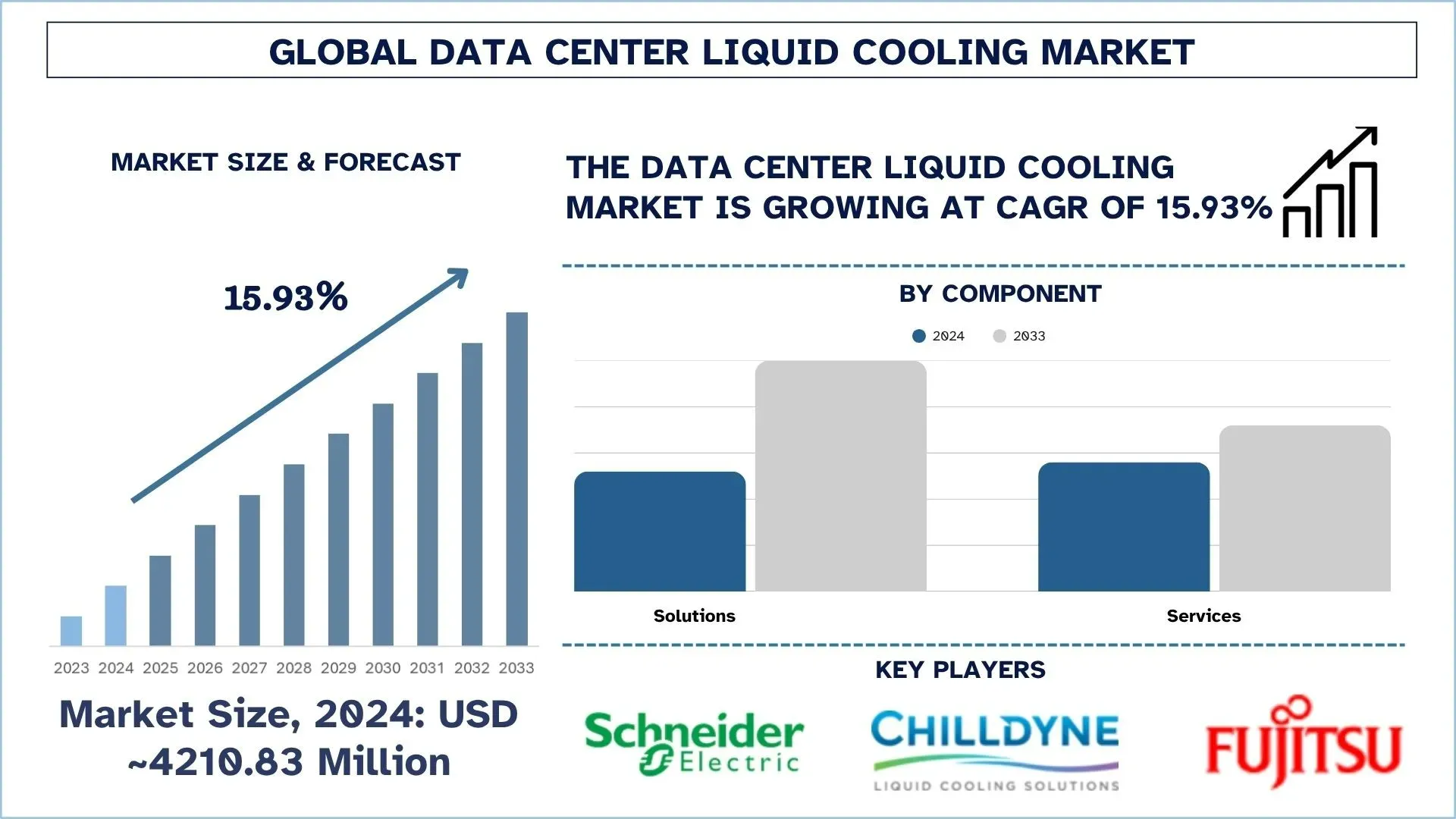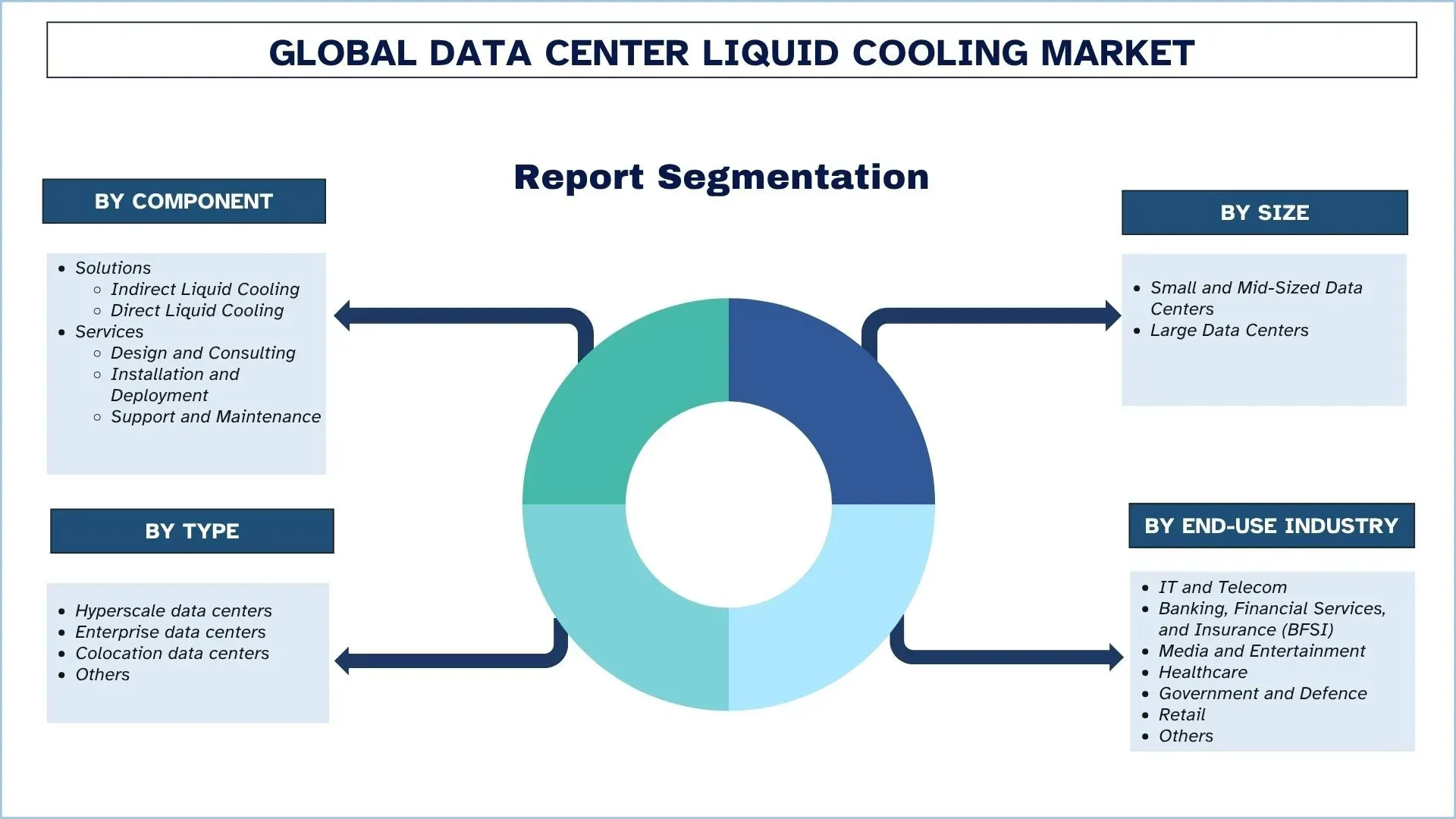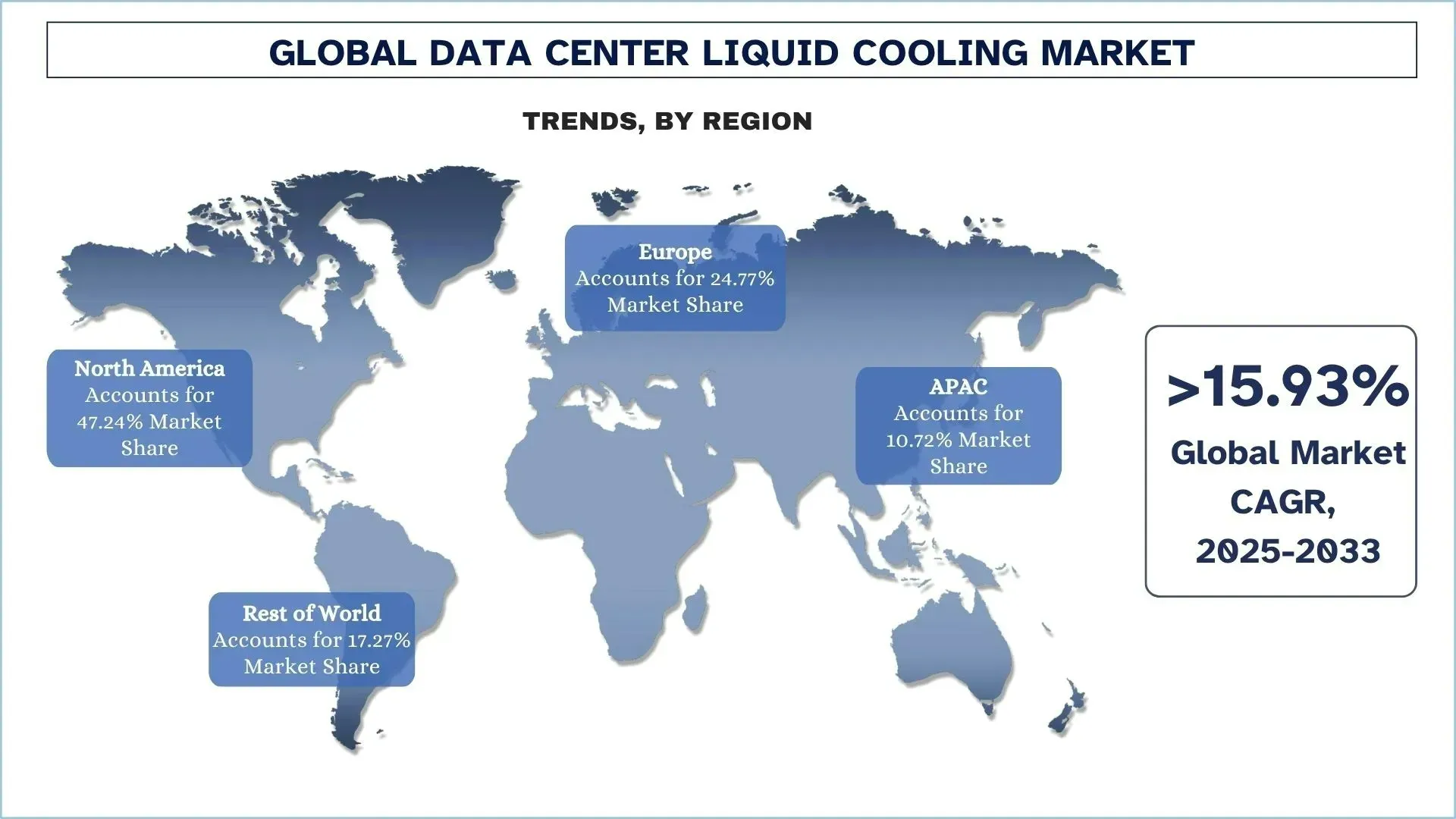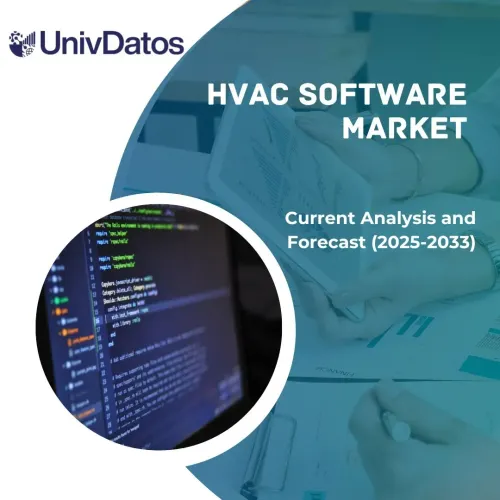- Home
- Chi siamo
- Settore
- Servizi
- Lettura
- Contattaci
Mercato del raffreddamento a liquido per data center: analisi attuale e previsioni (2025-2033)
Enfasi su Componente {Soluzioni, (Raffreddamento a Liquido Indiretto, Raffreddamento a Liquido Diretto), Servizi (Progettazione e Consulenza, Installazione e Implementazione, Supporto e Manutenzione)}; Dimensione (Data Center Piccoli e Medi, Data Center Grandi); Tipo (Data center Hyperscale, Data center Enterprise, Data center di Colocation e Altri); Settore di Utilizzo Finale (IT e Telecomunicazioni, Banche, Servizi Finanziari e Assicurativi (BFSI), Media e Intrattenimento, Sanità, Governo e Difesa, Retail, Altri); e Regione/Paese

Dimensione e previsione del mercato globale del raffreddamento a liquido per data center
Il mercato globale del raffreddamento a liquido per data center è stato valutato a 4210,83 milioni di dollari nel 2024 e si prevede che crescerà a un forte CAGR di circa il 15,93% durante il periodo di previsione (2025-2033F), grazie alla crescente potenza di calcolo dell'IA, alle normative standard delle organizzazioni e alla risoluzione dei vincoli di potenza a livello globale.
Il mercato globale delle soluzioni di raffreddamento a liquido per data center sta vivendo una crescita dinamica con la crescente domanda di calcolo ad alte prestazioni, IA e analisi di big data. Il tradizionale raffreddamento ad aria non è più efficiente man mano che i data center si espandono, guidando soluzioni di raffreddamento a liquido più efficienti. Alcune delle soluzioni, come il direct-to-chip e il raffreddamento a immersione, offrono una gestione termica superiore, consentendo densità di server più elevate e riducendo il consumo di energia. La necessità di efficienza energetica, la legislazione ambientale e l'uso di edge computing e servizi cloud stanno guidando la crescita nel mercato globale delle soluzioni di raffreddamento a liquido per data center. Inoltre, si prevede che il mercato si espanderà man mano che i data center si orienteranno per soddisfare anche le esigenze del calcolo in tempo reale. Infatti, il 21 maggio 2025 Delta ha lanciato la sua sbarra collettrice raffreddata a liquido Core Shell e la sbarra collettrice raffreddata ad aria HVDC, in grado di raggiungere fino a 50VDC/8000A e 800VDC/1000A, che fornirà un funzionamento coerente dei sistemi. Inoltre, nelle aree con raffreddamento a liquido più avanzato, i sistemi di raffreddamento liquido-liquido di Delta possono fornire un raffreddamento fino a 1.500 kW. Inoltre, Delta ha anche introdotto unità di distribuzione del refrigerante a livello di rack con un raffreddamento fino a 200kW e la capacità di fornire piastre fredde raffreddate a liquido per GPU e CPU per fornire un eccellente supporto termico per i chip di prossima generazione.
Tendenze del mercato globale del raffreddamento a liquido per data center
Questa sezione discute le principali tendenze del mercato che stanno influenzando i vari segmenti del mercato globale del raffreddamento a liquido per data center, come riscontrato dal nostro team di esperti di ricerca.
Aumento della domanda di simulazione ibrida
La crescente tendenza della simulazione ibrida nei data center sta catalizzando la crescita del mercato globale del raffreddamento a liquido per data center in modo robusto. La simulazione ibrida combina tecnologie di raffreddamento ad aria e a liquido, consentendo ai data center di gestire efficacemente i carichi termici fluttuanti relativi alle applicazioni di calcolo ad alte prestazioni (HPC) come l'intelligenza artificiale (IA) e l'apprendimento automatico. Poiché queste applicazioni comportano un calcolo ad alta densità, le tecniche di raffreddamento ad aria convenzionali di solito si rivelano inadeguate e, pertanto, vengono impiegate tecnologie di raffreddamento a liquido. Inoltre, l'adozione di infrastrutture di raffreddamento ibride sta guadagnando terreno in quanto i data center possono raggiungere un rapporto di efficacia dell'utilizzo di energia (PUE) più elevato, il che rappresenta una migliore efficienza energetica. In totale, la crescente domanda di simulazione ibrida per i data center sta alimentando l'espansione del mercato globale del raffreddamento a liquido per data center.
Segmentazione del settore del raffreddamento a liquido per data center
Questa sezione fornisce un'analisi delle principali tendenze in ogni segmento del rapporto sul mercato globale del raffreddamento a liquido per data center, insieme alle previsioni a livello globale, regionale e nazionale per il 2025-2033.
Le soluzioni di raffreddamento a liquido dominano il mercato del raffreddamento a liquido per data center.
In base al componente, il mercato è suddiviso in soluzioni e servizi. Le soluzioni sono ulteriormente segmentate in mercati di raffreddamento a liquido indiretto e raffreddamento a liquido diretto, mentre i servizi sono ulteriormente segmentati in progettazione e consulenza, installazione e implementazione, e supporto e manutenzione. Le soluzioni stanno dominando il mercato e stanno cambiando drasticamente le operazioni dei data center affrontando in modo economico il calore generato dalle applicazioni di calcolo ad alta densità. Rispetto al tradizionale raffreddamento ad aria, il DLC applica sistemi a base di liquido per raffreddare e dissipare il calore dai componenti più affidabili e orientati alle prestazioni direttamente. Ciò riduce in modo predominante il consumo di energia, diminuisce i costi operativi e impone impatti ambientali minimi. Le applicazioni di intelligenza artificiale e apprendimento automatico con elevata intensità di calcolo hanno ulteriormente accelerato lo sviluppo delle tecnologie DLC. Ad esempio, il 16 gennaio 2024, Aligned Data Centers ha annunciato il lancio della sua tecnologia di raffreddamento a liquido DeltaFlow~ TM una soluzione in attesa di brevetto progettata per supportare i requisiti di calcolo ad alta densità delle applicazioni di prossima generazione e del calcolo ad alte prestazioni (HPC), tra cui l'intelligenza artificiale (IA), l'apprendimento automatico (ML) e i supercomputer.
Il grande data center domina il mercato del raffreddamento a liquido per data center.
In base alle dimensioni, il mercato è segmentato in data center di piccole e medie dimensioni e grandi data center. Il segmento dei grandi data center ha dominato il mercato nell'anno storico in quanto può soddisfare la domanda di potenza di calcolo localizzata, scalabile ed economica. Non solo i dispositivi IoT (Internet of Things) sono cresciuti in modo esponenziale, ma la realtà in espansione delle applicazioni relative a tecnologie avanzate come l'intelligenza artificiale (IA) e il 5G ha ampliato il numero di punti dati relativi all'elaborazione dei dati in tempo reale. D'altra parte, i data center di piccole e medie dimensioni possono spesso essere più vicini ai dati nei loro ecosistemi, il che faciliterà la logistica dell'evasione e dell'elaborazione dell'edge computing che può portare a un livello inferiore di latenza e migliorare l'efficienza operativa in vari settori (ad esempio, assistenza sanitaria, telecomunicazioni, produzione, ecc.). La capacità dei design modulari e containerizzati di fornire un'infrastruttura rapida e flessibile consente a un'azienda di scalare e cambiare in base alle esigenze future e alle mutevoli esigenze. Infine, le crescenti preoccupazioni in merito alla protezione e alla conformità dei dati stanno creando una spinta verso i dati localizzati.
Si prevede che il Nord America crescerà a un ritmo considerevole durante il periodo di previsione.
Il Nord America è leader nel settore del raffreddamento a liquido per data center, attribuito alla presenza di importanti giganti tecnologici e operatori di data center. Ci sono molti data center hyperscale negli Stati Uniti, gestiti dai principali fornitori di servizi cloud e dai grandi nomi della tecnologia come Google, Amazon e Microsoft. La crescente domanda di calcolo ad alte prestazioni, con il crescente utilizzo di applicazioni di IA e ML, fa sorgere la necessità di soluzioni di raffreddamento avanzate nella regione. Inoltre, esiste un aumento dei controlli rigorosi sull'efficienza energetica e sulla sostenibilità ambientale che spingono per un maggiore utilizzo delle tecnologie di raffreddamento a liquido nei data center nordamericani. Si prevede che il mercato in questa regione crescerà a un buon CAGR nel periodo di previsione con gli investimenti strategici in corso attraverso lanci di prodotti, fusioni e acquisizioni strategiche, collaborazioni, ecc.
18 marzo 2024: Schneider Electric, leader nella trasformazione digitale della gestione dell'energia e dell'automazione, ha annunciato una collaborazione con NVIDIA per ottimizzare l'infrastruttura dei data center e ha aperto la strada a progressi rivoluzionari nell'intelligenza artificiale (IA) edge e nelle tecnologie di digital twin. Inoltre, un'attenzione particolare sarebbe rivolta all'abilitazione della distribuzione ad alta potenza, dei sistemi di raffreddamento a liquido e dei controlli, progettati per garantire una semplice messa in servizio e operazioni affidabili per il cluster a densità estrema.
Il 2 novembre 2023, Vertiv ha presentato Vertiv™ SmartMod™ Max CW, un data center modulare prefabbricato progettato per soddisfare la crescente domanda di implementazione rapida del calcolo. Questa soluzione configurabile e scalabile supportava fino a 200kW di carico IT totale in un singolo sistema che utilizzava il raffreddamento ad acqua refrigerata per ridurre l'impatto ambientale e l'efficienza energetica ed è stata disponibile in Nord America. Per un'ulteriore crescita, le aziende nella regione devono abbracciare i progressi nelle tecnologie di raffreddamento a liquido, come l'immersione e il direct-to-chip, per stare al passo con la crescente IA e i carichi di lavoro di calcolo ad alte prestazioni.

Gli Stati Uniti hanno detenuto una quota dominante del mercato nordamericano del raffreddamento a liquido per data center nel 2024
Gli Stati Uniti hanno una quota maggiore del mercato mondiale per il raffreddamento a liquido nei data center. Allo stesso tempo, i vantaggi dei data center hyperscale e la necessità di calcolo ad alte prestazioni hanno portato alla crescita di questo mercato. Inoltre, le sovvenzioni e i crediti d'imposta forniti dal governo degli Stati Uniti supportano l'implementazione di tecnologie altamente avanzate, rendendolo un hub di innovazione per i data center. Le aziende stanno accettando in modo aggressivo le soluzioni avanzate di raffreddamento a liquido per i data center per soddisfare la crescente crescita del calcolo ad alte prestazioni e dei carichi di lavoro di intelligenza artificiale. Anche i principali giganti tecnologici come Google, Microsoft e Meta stanno utilizzando tecnologie di raffreddamento complesse come l'immersione e le soluzioni direct-to-chip, che hanno il potenziale per assorbire il calore generato dal carico di lavoro dell'IA e dai servizi cloud.
Schneider Electric, uno dei leader globali nella trasformazione digitale della gestione dell'energia e dell'automazione, ha annunciato di aver stretto un accordo per acquisire una partecipazione di controllo in Motivair Corporation il 17 ottobre 2024. Motivair Corporation ha sede in Nord America ed è specializzata in raffreddamento a liquido e soluzioni avanzate di gestione termica per sistemi di calcolo ad alte prestazioni. Si prevede che il portafoglio di soluzioni termiche ad alta capacità e di raffreddamento a liquido direct-to-chip di Schneider Electric migliorerà le sue offerte esistenti e promuoverà l'innovazione nella tecnologia di raffreddamento con questa acquisizione.
Il 3 ottobre 2024, Jabil Inc., uno dei leader globali nelle soluzioni di progettazione, produzione e catena di approvvigionamento, ha annunciato il completamento dell'acquisizione di Mikros Technologies LLC. Mikros Technologies LLC è uno dei leader pionieristici nell'ingegneria e nella produzione di soluzioni di raffreddamento a liquido per la gestione termica. Jabil Inc. sarebbe in grado di aiutare i propri clienti a gestire gli elevati requisiti termici dei prodotti attuali e di prossima generazione, tenendo conto al contempo della sostenibilità e dei costi con l'acquisizione di Mikros Technologies LLC.

Panorama competitivo del settore del raffreddamento a liquido per data center
Il mercato globale del raffreddamento a liquido per data center è competitivo, con diversi attori di mercato globali e internazionali. I principali attori stanno adottando diverse strategie di crescita per migliorare la loro presenza sul mercato, come partnership, accordi, collaborazioni, nuovi lanci di prodotti, espansioni geografiche e fusioni e acquisizioni.
Principali aziende di raffreddamento a liquido per data center
Alcuni dei principali attori del mercato sono Schneider Electric, AQ Compute Services Germany GmbH (Aquila Group); Asetek Inc. A/S (Asetek A/S); RITTAL GmbH & Co. KG (Friedhelm Loh Group); Vertiv Group Corp. (Vertiv Holdings Co.); Green Revolution Cooling, Inc.; Chilldyne, Inc.; FUJITSU (Furukawa Group); DCX INC; Submer.
Sviluppi recenti nel mercato del raffreddamento a liquido per data center
Il 15 maggio 2025, Flex ha dichiarato l'acquisizione di JetCool Technologies, specializzata nella fornitura di soluzioni di raffreddamento a liquido per data center e calcolo ad alte prestazioni. Questa acquisizione strategica amplierebbe ulteriormente le capacità di Flex nell'affrontare i problemi di alimentazione, calore e scalabilità dei data center hyperscale e aziendali distribuiti con carichi di lavoro di IA.
Il 17 ottobre 2024, Schneider Electric ha annunciato l'intenzione di acquistare una partecipazione di controllo in Motivair Corp, uno specialista nel raffreddamento a liquido per il calcolo ad alte prestazioni di circa 850 milioni di dollari, per la crescita dei data center.
Il 20 maggio 2024, la società di investimento King Street Capital Management ha annunciato di aver acquisito una partecipazione di maggioranza nel fornitore di colocation della Silicon Valley denominato Colovore, un operatore di data center raffreddato a liquido in California.
Copertura del rapporto sul mercato globale del raffreddamento a liquido per data center
Attributo del rapporto | Dettagli |
Anno base | 2024 |
Periodo di previsione | 2025-2033 |
Slancio di crescita | Accelerare a un CAGR del 15,93% |
Dimensione del mercato 2024 | 4210,83 milioni di dollari |
Analisi regionale | Nord America, Europa, APAC, Resto del mondo |
Regione principale che contribuisce | Si prevede che il Nord America dominerà il mercato durante il periodo di previsione. |
Paesi chiave coperti | Stati Uniti, Canada, Germania, Francia, Regno Unito, Italia, Paesi Bassi, Cina, Giappone, India e Australia |
Aziende profilate | Schneider Electric; AQ Compute Services Germany GmbH (Aquila Group); Asetek Inc. A/S (Asetek A/S); RITTAL GmbH & Co. KG (Friedhelm Loh Group); Vertiv Group Corp. (Vertiv Holdings Co.); Green Revolution Cooling, Inc.; Chilldyne, Inc.; FUJITSU (Furukawa Group); DCX INC; Submer |
Ambito del rapporto | Tendenze di mercato, fattori trainanti e vincoli; stima e previsione dei ricavi; analisi della segmentazione; analisi della domanda e dell'offerta; panorama competitivo; profilazione aziendale |
Segmenti coperti | Per componente, per dimensione, per tipo; per settore di utilizzo finale; per regione/paese |
Motivi per acquistare il rapporto sul mercato del raffreddamento a liquido per data center:
Indice
Metodologia di ricerca per l'analisi del mercato globale del raffreddamento a liquido per data center (2025-2033)
Abbiamo analizzato il mercato storico, stimato il mercato attuale e previsto il mercato futuro del mercato globale del raffreddamento a liquido per data center per valutarne l'applicazione nelle principali regioni del mondo. Abbiamo condotto un'esauriente ricerca secondaria per raccogliere dati storici di mercato e stimare le dimensioni attuali del mercato. Per convalidare queste informazioni, abbiamo esaminato attentamente numerosi risultati e ipotesi. Inoltre, abbiamo condotto interviste primarie approfondite con esperti del settore lungo tutta la catena del valore del raffreddamento a liquido per data center. Dopo aver convalidato i dati di mercato attraverso queste interviste, abbiamo utilizzato approcci sia top-down che bottom-up per prevedere le dimensioni complessive del mercato. Abbiamo quindi impiegato metodi di suddivisione del mercato e di triangolazione dei dati per stimare e analizzare le dimensioni del mercato dei segmenti e sottosegmenti del settore.
Ingegneria del mercato
Abbiamo impiegato la tecnica di triangolazione dei dati per finalizzare la stima complessiva del mercato e derivare numeri statistici precisi per ogni segmento e sottosegmento del mercato globale del raffreddamento a liquido per data center. Abbiamo suddiviso i dati in diversi segmenti e sottosegmenti analizzando vari parametri e tendenze, tra cui componenti, dimensioni, tipo, settore di utilizzo finale e regioni all'interno del mercato globale del raffreddamento a liquido per data center.
L'obiettivo principale dello studio sul mercato globale del raffreddamento a liquido per data center
Lo studio identifica le tendenze attuali e future nel mercato globale del raffreddamento a liquido per data center, fornendo approfondimenti strategici per gli investitori. Evidenzia l'attrattiva del mercato regionale, consentendo ai partecipanti del settore di accedere a mercati non sfruttati e ottenere un vantaggio di first-mover. Altri obiettivi quantitativi degli studi includono:
Analisi delle dimensioni del mercato: valutare le dimensioni attuali e previste del mercato del mercato globale del raffreddamento a liquido per data center e dei suoi segmenti in termini di valore (USD).
Raffreddamento a liquido per data center Segmentazione del mercato: i segmenti nello studio includono aree di componenti, dimensioni, tipo, settore di utilizzo finale e regioni.
Quadro normativo e analisi della catena del valore: esaminare il quadro normativo, la catena del valore, il comportamento dei clienti e il panorama competitivo del settore del raffreddamento a liquido per data center.
Analisi regionale: condurre un'analisi regionale dettagliata per aree chiave come Asia Pacifico, Europa, Nord America e il resto del mondo.
Profili aziendali e strategie di crescita: profili aziendali del mercato del raffreddamento a liquido per data center e le strategie di crescita adottate dagli operatori di mercato per sostenersi nel mercato in rapida crescita.
Domande frequenti FAQ
D1: Qual è l'attuale dimensione del mercato e il potenziale di crescita del mercato globale del raffreddamento a liquido per data center?
Il mercato globale del raffreddamento a liquido per data center è stato valutato a 4210,83 milioni di dollari nel 2024 e si prevede che crescerà a un CAGR del 15,93% durante il periodo di previsione (2025-2033).
Q2: Quale segmento detiene la quota maggiore del mercato globale del raffreddamento a liquido per data center in base al componente?
Il segmento delle soluzioni sta dominando il mercato e sta cambiando drasticamente le operazioni dei data center affrontando economicamente il calore generato da applicazioni di calcolo ad alta densità. Rispetto al raffreddamento ad aria tradizionale, il DLC applica sistemi basati su liquidi per raffreddare e dissipare direttamente il calore dai componenti più affidabili e orientati alle prestazioni.
Q3: Quali sono i fattori trainanti per la crescita del mercato globale del raffreddamento a liquido dei data center?
L'aumento della potenza computazionale dell'IA, la regolamentazione degli standard da parte delle organizzazioni e la gestione dei vincoli di potenza a livello globale sono alcuni dei fattori che guidano il mercato globale del raffreddamento a liquido dei data center.
Q4: Quali sono le tecnologie e le tendenze emergenti nel mercato globale del raffreddamento a liquido per data center?
L'aumento della domanda di simulazione ibrida e l'integrazione di AI e Machine Learning sono le tendenze emergenti che plasmano il futuro del settore.
D5: Quali sono le principali sfide nel mercato globale del raffreddamento a liquido per data center?
Gli elevati costi iniziali e le complessità tecniche sono alcune delle principali sfide affrontate dal mercato del raffreddamento a liquido per data center.
Q6: Quale regione domina il mercato globale del raffreddamento a liquido dei data center?
Il Nord America è leader nel settore del raffreddamento a liquido per data center, attribuito alla presenza di importanti colossi tecnologici e operatori di data center. Negli Stati Uniti esistono molti data center hyperscale, gestiti dai principali fornitori di servizi cloud e grandi aziende tecnologiche come Google, Amazon e Microsoft.
Q7: Chi sono i principali attori nel mercato globale del raffreddamento a liquido per data center?
Alcune delle principali aziende nel mercato globale del raffreddamento a liquido per data center sono:
• Schneider Electric
• AQ Compute Services Germany GmbH (Aquila Group)
• Asetek Inc. A/S (Asetek A/S)
• RITTAL GmbH & Co. KG (Friedhelm Loh Group)
• Vertiv Group Corp. (Vertiv Holdings Co.)
• Green Revolution Cooling, Inc.
• Chilldyne, Inc.
• FUJITSU (Furukawa Group)
• DCX INC
• Submer
Q8: Quali sono le opportunità di investimento nel mercato del raffreddamento a liquido dei data center?
Il mercato del raffreddamento a liquido per data center presenta interessanti opportunità di investimento, spinte dalla crescente domanda di infrastrutture efficienti dal punto di vista energetico e sostenibili. Le aree chiave per l'investimento includono tecnologie di raffreddamento avanzate come i sistemi a immersione e direct-to-chip, che sono essenziali per la gestione degli elevati carichi termici associati all'intelligenza artificiale e ai carichi di lavoro di calcolo ad alte prestazioni.
Q9: In che modo le normative influenzano il mercato del raffreddamento a liquido per data center?
Le normative stanno influenzando in modo significativo l'adozione di tecnologie di raffreddamento a liquido nei data center, imponendo standard ambientali e di efficienza energetica più severi. Ad esempio, il Titolo 24 del codice energetico della California penalizza i data center raffreddati ad aria che superano un Power Usage Effectiveness (PUE) di 1.15 durante le ore di punta, spingendo gli operatori ad ammodernare i sistemi con il raffreddamento a liquido per conformarsi a tali normative.
Correlati Report
I clienti che hanno acquistato questo articolo hanno acquistato anche










